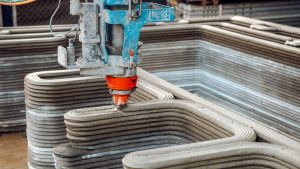
Momentum for 3D Printed Homes
Texas is leading the way.
Imagine pulling up to a house that looked like it was wrapped in thick corduroy. With its curved walls it looks like it could have been plucked straight from the plains of Tatooine (forgive the Star Wars reference) and dropped into a residential Texas neighborhood. You walk in, and to your surprise, the interior walls look exactly like the exterior ones! Well, if you lived in Georgetown, Texas you don’t have to imagine it. That’s exactly what you’d find.
This is the current design of 3D printed homes and you can now find 100 of them in a development built from a partnership between Lennar, the country’s second largest home builder, and Icon, an Austin based start-up and leader in the 3D printing industry.
The build out is part of the Wolf Ranch development and began in 2022. The 2 to 3 bedroom homes in this community currently start just under $400,000 and go up to $490,000 with floor plans ranging from 1,517 sf to 2,112 sf.
Do the benefits outweigh the unconventional look?
Initially, ICON was using two 40-foot Vulcan robotic construction systems, but in its second year began utilizing 11. These machines are able to do the work of 12 men, run 24 hours a day and produce two homes a week.
The printers lay down layers of a substance called Carbon X, a cementitious material known for its durability and strength, making these homes wind resistant, water resistant, mold resistant and fire resistant. With natural disasters seemingly on the rise, these homes are built to withstand whatever is thrown at them.
Another great advantage of having a cement house is the energy efficiency. I don’t know if you know anyone with a cinder block house, but during summer they stay cool and remain warm in the winter, reducing the workload of your HVAC system, lowering utility bills.
Holly Feekings, a resident of the community said, “the best part of buying a 3D printed home was the electricity bill. It was $26 last month because the concrete retains the temperature, both hot and cold.”
What’s next for ICON?
ICON has partnered with Michael Hsu Office of Architecture for an upcoming Austin suburb infill project called Mueller. This is a mixed-income community and the 200 homes expected to be built will come in 3 different two-story floor plans that range from 650 sf to 2,400 sf. The smallest unit being a 1 bedroom 1.5 bathroom.
What differentiates this project from the one at Wolf Ranch is that these homes will be a blend, 3D printed construction on the first floor and traditional stick built construction on the second floor. At Wolf Ranch, the only structural part of the home that isn’t 3D printed is the metal roof.
Here’s my take.
Sure, the homes may look odd at first glance, but I think people need to learn to look past the aesthetic differences and focus on the tremendous benefit this technology provides.
Construction costs in California are sky high, affordability is at an all-time low, homeowners insurance is a mess and homes are being decimated by wildfires all too often. The fire resistant aspect of this material alone should cause builders in our area to seriously consider how they can utilize this style of construction.
I’m hoping once the scalability of ICON and other companies like it improves, we see a significant change in the way some of our homes are built along with a decline in construction costs for the first time since Sears began selling their kit homes in the early 1900’s.
I don’t know if this is the answer to California’s housing issues, but it could be one of them.


 Facebook
Facebook
 X
X
 Pinterest
Pinterest
 Copy Link
Copy Link